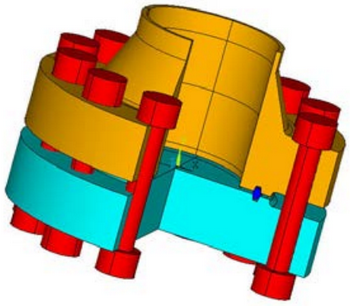How can a team of mechanical engineers garantee the reliability and safety of bolted joints in new cars, planes or mobile phones, before they go into production?
It is a well known fact that dynamic forces introduce stress and fatigue into mechanical systems and reduce their service life. Vibration can loosen fasteners, leading to dramatic failures. Finite element analysis (FEA) is essential for determining structural robustness, but cannot predict accurately fastener self-loosening behaviour, while prototyping in real conditions is costly and time-consuming.
Successful companies validate new bolted joints designs by performing dynamic fastener tests in laboratory on a transverse vibration test machine. This rapid and cost-effective “Junker test” test allows engineers to simulate real life dynamic vibration conditions on a single component or an assembly. The data analysis aids engineers to specify the right choice of bolts, nuts and fastener locking products and guarantee the assembly will remain tightly secured even in harsh service conditions.
In the early design stage, engineers can validate a new bolted joint design with a bespoke vibration test reproducing the actual service condition of the application. This is called the “tested-by-me” procedure.
Fasteners will not come loose if the clamping force acting on the joint is sufficient to overcome the external forces sustained during actual operation, and prevent transverse movement between the clamped parts.

Figure 1: Fastener vibration test results comparing the remaining preload of different fasteners under specific ‘Tested-by-me’ conditions
The “tested-by-me” approach involves mounting a sample of the bolted joint in a vibration test rig using the same material, dimensions and surface properties as in the actual application. In a vibration test, the bolted joint will be subjected to increasing vibration displacement and transverse force, until the exact point at which the displacement be- comes sufficient to overcome the frictional resistance in the joint, induces movement between the clamped parts and starts rotational self-loosening. This point is known as the marginal slip. The design engineer will then compare the measured transverse force value from the vibration test rig to the requirement for the actual application.
A corrective coefficient factor C_{F} is then applied to relate the measured transverse force in the test rig and the transverse force that would result from the same conditions in the application.
The maximal transverse force value that can be withstood by the bolted joint F_{R} in real conditions is:
Where F_{T} = the measured transverse force at which the bolted joint starts self-loosening.
F_{R} can be compared to the calculated maximum transverse force F_{C} estimated for the application during the design stage. The bolted joint design is validated if the real transverse force required to self-loosen the bolted joint F_{R} is higher than the calculated transverse force handled by the application, as follows:
The fastener vibration test has become the reference for assessing the security of fasteners and assemblies in real service conditions. Modern fastener vibration and torque test benches provide detailed dynamic analysis of all aspects of fastener performance and help engineers design safer products.
Find out how the Fastener Transverse Vibration Test can help you design safer bolted joints
We highly recommend studying these resources:
1. Junker G, New Criteria for Self-Loosening of Fasteners Under Vibration, Transactions of the Society of Automotive Engineers, Vol. 78, 1969, pp. 314-335, New York
3. DIN 25201-4:2010-03 Annex B. Test specification for demonstrating the resistance to self-loosening of secured bolted joints, Deutsches Institut für Normung c.V., Berlin 2010
4. ISO 16130:2015 Dynamic testing of the locking behaviour of bolted connections under transverse loading conditions (vibration test), International Organisation for Standardization, Geneva 2015


